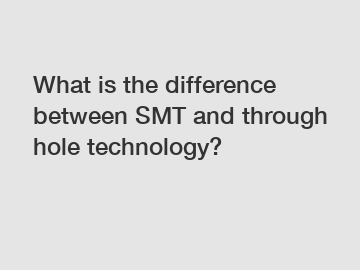Jan. 19, 2024
Machinery
Hayawin Product Page
What is the difference between SMT and through-hole technology?
In the world of electronics manufacturing, two primary methods are commonly used to mount components onto printed circuit boards (PCBs) - Surface Mount Technology (SMT) and through-hole technology. Both techniques have their own advantages and applications, but they differ significantly in terms of their assembly processes, component types, and overall capabilities. In this article, we will explore the differences between SMT and through-hole technology to gain a better understanding of their unique characteristics.

SMT Technology:
Surface Mount Technology, also known as SMT, is a widely utilized method for mounting electronic components onto PCBs. This technology involves attaching components directly onto the surface of the board, instead of passing the component leads through drilled holes as in through-hole technology. This allows for a more efficient and automated assembly process. Here are some key aspects of SMT:
1. Component Size and Placement: SMT components are generally smaller and more compact than through-hole components, making them ideal for high-density PCB designs. With the help of automated pick-and-place machines, SMT components can be accurately positioned on the board, enabling manufacturers to achieve higher production speeds.
2. Efficiency and Cost: SMT technology offers higher efficiency in terms of assembly speed, as it can mount multiple components simultaneously. This results in reduced production costs and overall manufacturing time, making it a preferred choice for mass production.
3. Higher Frequency Applications: Due to the smaller size of SMT components and the closer proximity to the board, SMT is often preferred for high-frequency applications. The shorter component leads and reduced parasitic capacitance and inductance allow for better signal integrity and improved performance at higher frequencies.
Through-hole Technology:
Through-hole technology has been around for many years and is still commonly used today, despite the rise of SMT. It involves the insertion of component leads through pre-drilled holes on the PCB and then soldering them on the opposite side of the board. Let's look at some key aspects of through-hole technology:
1. Component Reliability: Through-hole components offer excellent mechanical stability and are less prone to damage from external factors such as vibrations or mechanical stress. This makes them suitable for applications where reliability is paramount, such as industrial equipment or automotive systems.
2. Heat Dissipation: Due to the larger size of through-hole components, they often provide better heat dissipation capabilities compared to SMT components. This makes them suitable for power electronics or applications requiring high current-handling capacities.
3. Prototyping and Repairs: Through-hole technology is widely used during the prototype phase of PCB development, as it allows for easy component replacement and repair. Components can be easily desoldered and replaced when needed without damaging the board.
In conclusion, while both SMT and through-hole technology have their own advantages and applications, the choice between the two depends on various factors such as the intended use, production volume, and component characteristics. SMT technology is ideal for high-density PCB designs, mass production, and high-frequency applications. On the other hand, through-hole technology offers better mechanical stability, heat dissipation, and ease of prototyping and repairs. Understanding the differences between these two methods helps manufacturers and designers make informed decisions based on their specific requirements.
For more information about SMT and through-hole technology or any other electronics manufacturing processes, please contact us. We specialize in providing comprehensive solutions for all your PCB assembly needs.
If you are looking for more details, kindly visit our website.
For more pcb handling equipmentinformation, please contact us. We will provide professional answers.
Previous: How is a blowout preventer installed?
Next: Simplify Your Plate Loading Process with Auto Suction Plate Loader: An Efficient Solution!
If you are interested in sending in a Guest Blogger Submission,welcome to write for us!
All Comments ( 0 )